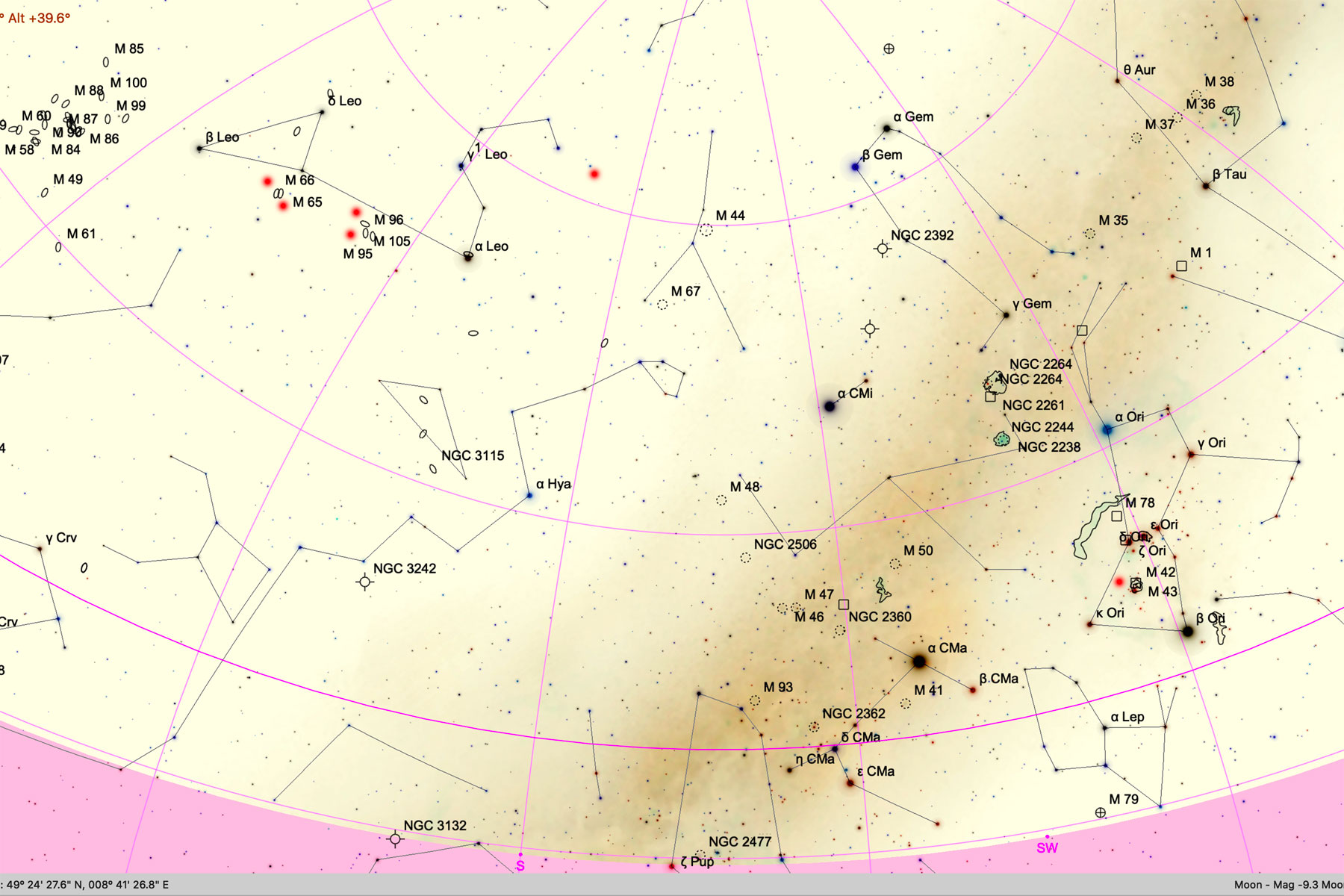Deep Sky Spring Observations April 2020
Conditions | Observation Overview | List of Observed Sky Objects | References
In April 2020, I did simple "deep-sky spring observations," which might be of interest to other beginners and are therefore described here. They took place in Mühlhausen/Kraichgau (Germany)..
Conditions
Sky Region and Objects
I observed in various sky areas as shown in the sky map below.
Overview Map
The following inverted map shows approximately the sky area that I primarily browsed during my observations (and some of the observed objects):
Click the map for a larger version - it opens in a new window (Image Courtesy of SkySafari Astronomy, www.simulationcurriculum.com)
Observation Time
The observations were done in April 2020.
Observation Location
The observations took place in Mühlhausen/Kraichgau (Germany):
- Coordinates: 49° 15′ N , 8° 43′ E
- Coordinates (dec.): 49.25° N, 8.72° E
Devices Used
I used the C8 on the AZ4 mount, the PS72 on the AZ Pronto mount, and the Skymax-127 also on the AZ Pronto mount.
General Conditions
In Mühlhausen/Kraichgau, the sky was not particularly dark.
Observation Overview
| Date 2020 |
Observed Objects | Details, Remarks | Further Observations and Remarks | Devices Used | Eyepieces Used |
| Apr 4-6 MH |
GN: M 42/43 | Orion: Apr 4: Observed with SM-127, photographing the Orion Nebula was difficult (hitting the target, focusing), but I got a result Apr 5: Observed with SM-127; Orion nebula (focusing difficult), but results with RX100 M4, visually, the nebula was hardly visible because of the moon ; moon with RX100 M4 and also purely visually, but already very faint... Binoculars (LT, OM): Venus and Pleiades, in the Pleiades only the biggest stars ("carriage") visible Apr 6: Observed and photographed with PS72 and SM-127. PS72: Half-Venus seen well with 24, 16, and 4 mm (108 x); at the end with less "color"; also observed and photographed M 42 with RX100 M4 (with and without zoom) SM-127: again observed and photographed with RX100 M4 the now nearly full moon |
Attempts to photograph the Orion Nebula M 42/43 with small telescopes and a normal camera, | PS72 on AZ Pronto, Skymax-127 on AZ Pronto | 32 mm |
| Apr 23 MH |
G: M 65, M 66, M 95, M 96, NGC
2903 Venus |
Leo: Observed NGC 2903 (very faint), the pair M 65/66, M 95, M 96, and NGC 3628 (eVscope only) in parallel to the eVscope; all the galaxies were rather faint (Astrid saw them better than me); M 65 and 66 could be seen in the same field of view. Overall, all the galaxies were very faint despite new moon; probably, the PS72 would have found none of them... The eVscope found all the galaxies, but had some problems with the Enhanced Vision mode (at most with NGC 2903) |
Comparison of the C8 with the eVscope based on some Leo galaxies; new
moon, but the sky was still fairly bright.
Venus crescent photographed with C8 |
C8 on AZ4 | C8: 40, 26 mm |
Bold: First observation during this observation period; all observations done in Mühlhausen/Kraichgau (MH); G = galaxy, OC = open star cluster, GC = globular star cluster, GN = galactic nebula, PN = planetary nebula, P = star pattern, DS = double star
List of Observed Sky Objects
Object details can be obtained via the links to the relevant deep sky objects.
|
DSO
Details |
Name | Constellation | Type | Bino* | PS72 | SM127 | C8 | C8R | Remarks |
| M 42/43 | Orion Nebula | Orion | GN | yes | yes | Made photo attempts with the Sony RX100 M4 | |||
| M 65 | Leo | G | yes | Faint, observed together with M 66 in the same field of view | |||||
| M 66 | Leo | G | yes | Faint, observed together with M 65 in the same field of view | |||||
| M 95 | Leo | G | yes | Faint | |||||
| M 96 | Leo | G | yes | Faint | |||||
| NGC 2903 | Leo | G | yes | Very faint |
*) LT = 10 x 25 binoculars, TS = 10 x 60 binoculars; G = galaxy, OC = open star cluster, GC = globular star cluster, DS = double star, P = star pattern, GN = galactic nebula, PN = planetary nebula, MW = Milky Way, C = comet
References
Books
- Michael Feiler & Philip Novak (2023). Deep Sky Reiseatlas (5. Auflage), Oculum Verlag (ISBN 978-3-949370-04-5)
www.oculum-verlag.de/detailview?no=608 - Ronald Stoyan (2021). Deep Sky Reiseführer (6. Auflage), Oculum Verlag (ISBN 978-3-938469-72-9)
www.oculum-verlag.de/detailview?no=603 - Erich Karkoschka (2022). Atlas für Himmelsbeobachter, Kosmos Verlag (EAN: 9783440173602)
www.kosmos.de/de/atlas-fur-himmelsbeobachter_1074889_9783440173602
On this Website
- Overview of Observations
- DSO List (Collected from Books)
- Omegon Photography Scope 72/432 ED OTA Information (2.8" Refractor)
- Sky-Watcher Skymax-127 OTA Information (5" Maksutov-Cassegrain)
- Celestron C8 OTA Information (8" Schmidt-Cassegrain)
- Sky-Watcher AZ Pronto Mount Information
- Sky-Watcher AZ4 Mount Information
| 28.04.2024 |
